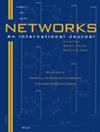二边连通最小分支顶点问题的遗传方法
IF 1.3
4区 计算机科学
Q4 COMPUTER SCIENCE, HARDWARE & ARCHITECTURE
引用次数: 0
摘要
本文章由计算机程序翻译,如有差异,请以英文原文为准。
A genetic approach for the 2‐edge‐connected minimum branch vertices problem
This article addresses the 2‐edge‐connected minimum branch vertices problem, a variant of the minimum branch vertices problem in which the spanning subgraph is required to be 2‐edge‐connected for survivability reasons. The problem has been recently introduced and finds application in optical networks design scenarios, where branch vertices are associated to switch devices that allow to split the entering light signals and send them to several adjacent vertices. An exact approach to the problem has been proposed in the literature. In this paper, we formally prove its NP‐completeness and propose a genetic algorithm, which exploits some literature‐provided procedures for efficiently checking and restoring solutions feasibility, and makes use of novel ad‐hoc designed operators aiming to improve their values, reducing the number of branch vertices. The computational tests show that, on the benchmark instances, the genetic algorithm very often finds the optimal solution. Moreover, in order to further investigate the effectiveness and the performance of our algorithm, we generated a new set of random instances where the optimal solution is known a priori.
求助全文
通过发布文献求助,成功后即可免费获取论文全文。
去求助
来源期刊

Networks
工程技术-计算机:硬件
CiteScore
4.40
自引率
9.50%
发文量
46
审稿时长
12 months
期刊介绍:
Network problems are pervasive in our modern technological society, as witnessed by our reliance on physical networks that provide power, communication, and transportation. As well, a number of processes can be modeled using logical networks, as in the scheduling of interdependent tasks, the dating of archaeological artifacts, or the compilation of subroutines comprising a large computer program. Networks provide a common framework for posing and studying problems that often have wider applicability than their originating context.
The goal of this journal is to provide a central forum for the distribution of timely information about network problems, their design and mathematical analysis, as well as efficient algorithms for carrying out optimization on networks. The nonstandard modeling of diverse processes using networks and network concepts is also of interest. Consequently, the disciplines that are useful in studying networks are varied, including applied mathematics, operations research, computer science, discrete mathematics, and economics.
Networks publishes material on the analytic modeling of problems using networks, the mathematical analysis of network problems, the design of computationally efficient network algorithms, and innovative case studies of successful network applications. We do not typically publish works that fall in the realm of pure graph theory (without significant algorithmic and modeling contributions) or papers that deal with engineering aspects of network design. Since the audience for this journal is then necessarily broad, articles that impact multiple application areas or that creatively use new or existing methodologies are especially appropriate. We seek to publish original, well-written research papers that make a substantive contribution to the knowledge base. In addition, tutorial and survey articles are welcomed. All manuscripts are carefully refereed.
 求助内容:
求助内容: 应助结果提醒方式:
应助结果提醒方式:


